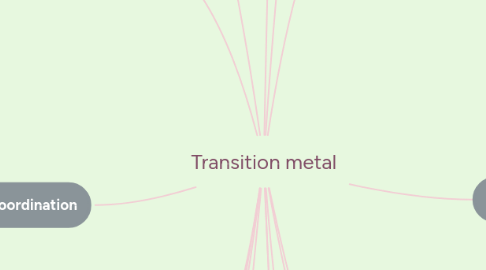Transition metal
by Noura m


1. Werner coordination
1.1. Every metal atom has a fixed number of coordination numbers
1.2. The metal atoms tends to satisfy bofhs
1.2.1. Primary is by negative ions
1.2.2. Secondary is by negative or netural
1.3. The coordination number are always directed towards the fixed position in space
2. Properties
2.1. Electronic configuration
2.2. Oxidation state
2.3. Complex ionsformat
2.4. Colored ions
2.5. Catalytic activity
2.6. Magnetic
2.7. Abundance
3. Factors effecting complexation
3.1. Presence of vacant d orbitals
3.2. Charge on the metal
3.3. Size of the metal
4. Types of ligands
4.1. Monodentate
4.1.1. Use only one donor atoms
4.2. Polydentate
4.2.1. Use more than one atom
5. Nomenclature of complexes
6. Magnatic moument
7. Jahn tellar theory
8. 1- find oxidation number. 2-find electrons(d). 3-find hybrid orbitals and compound shape. 4-determination of geometry.
8.1. Tetrahedral geometry
8.2. Square planar
8.3. Octahedral
8.3.1. dwsp3
9. Coordination compounds
9.1. Primary valency
9.2. Secondary
10. Types of isomerism
10.1. Stural isomerism
10.1.1. Coordination isomerism
10.1.2. Ionisation isomerism
10.1.3. Hydrate isomerism
10.1.4. Linkage isomerism
10.2. Stereo isomerism
10.2.1. Geometrical isomerism
10.2.2. Optical isomerism
11. Valance bond theory
12. Crystal field theory
12.1. Octahedral
12.1.1. p
12.1.1.1. t1u
12.1.2. s
12.1.2.1. a1g
12.1.3. d
12.1.3.1. eg
12.1.3.2. t2g
12.2. Square planer
12.2.1. p
12.2.1.1. e1u
12.2.1.2. P2u
12.2.2. s
12.2.2.1. A1g
12.2.3. d
12.2.3.1. B1g
12.2.3.2. B2g
12.2.3.3. a1g
12.2.3.4. E1g
12.3. Sp3d2
12.4. Tetrahedral
12.4.1. p
12.4.1.1. t1
12.4.2. s
12.4.2.1. a1
12.4.3. d
12.4.3.1. t2
12.4.3.2. e
